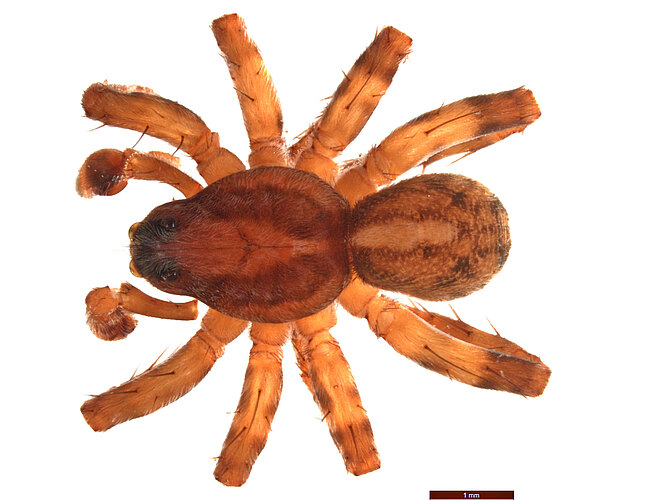Kerewong Artoria Artoria kerewong Framenau & Baehr, 2018
Fauna Portal species: 7675Diagnosis
(after Framenau & Baehr 2018): The pedipalp morphology of males of A. kerewong is distinct within the genus, with the terminal section of the tegular apophysis having both a pointed apical and a pointed basal tip. The basoembolic apophysis is the longest amongst the known Artoria species. The female of A. kerewong is currently unknown.
Status
- native
Linnean Holotype
Australia
- New South Wales
Fauna Portal Records
The map shows all records that have been verified as part of the Fauna Portal project and may not represent the true distribution of a species. Specifically, for described species, check the link to the Atlas of Living Australia on this page for potential wider distributions. Fauna Portal Reference specimens and Linnean types are shown in red. If you identified a specimen that exceeds the distribution of an undescribed species as illustrated here, please contact the Fauna Portal team who can assist with the lodgement of the specimen in a public institution and display on the map.
Publications
Framenau VW, Baehr, BC (2018): The wolf spider genus Artoria in New South Wales and the Australian Capital Territory, Australia (Araneae, Lycosidae, Artoriinae). Evolutionary Systematics. 2: 169 - 241
Araneae (Spiders)
- Actinopodidae
- Anamidae
- Araneae fam. indet.
- Araneidae
- Archaeidae
- Argyronetidae
- Arkyidae
- Barychelidae
- Cheiracanthiidae
- Clubionidae
- Corinnidae
- Cycloctenidae
- Deinopidae
- Desidae
- Dictynidae
- Filistatidae
- Gnaphosidae
- Halonoproctidae
- Hersiliidae
- Idiopidae
- Lamponidae
- Linyphiidae
- Lycosidae
- Allotrochosina
- Anomalosa
- Artoria
- aculeata
- albopedipalpis
- albopilata
- alta
- atrata
- avona
- barringtonensis
- beaury
- belfordensis
- berenice
- bondi
- booderee
- cingulipes
- comleroi
- corowa
- emu
- equipalus
- extraordinaria
- falcata
- flavimana
- FP-11765
- FP-13189
- FP-13237
- gloriosa
- grahammilledgei
- helensmithae
- howquaensis
- impedita
- incrassata
- inversa
- kanangra
- kerewong
- lamellata
- lineata
- linnaei
- maroota
- mckayi
- mungo
- munmorah
- myallensis
- parvula
- pileata
- pinnata
- plicata
- quadrata
- retorta
- schizocoides
- slatyeri
- strepera
- taeniata
- taeniifera
- terania
- triangularis
- trifida
- ulrichi
- victoriensis
- wilkiei
- Artoriopsis
- Costacosa
- Diahogna
- Dingosa
- Genus 2556 (ariadnae grp)
- Genus 3448 (leonhardii gp)
- Genus 3491 (laeta grp)
- Genus 3643 (yalkara grp)
- Hoggicosa
- Hogna
- Kangarosa
- Knoelle
- Kochosa
- Lycosidae gen. indet.
- Mainosa
- Portacosa
- Tapetosa
- Tasmanicosa
- Tetralycosa
- Tuberculosa
- Venator
- Venatrix
- Venonia
- Zoica
- Allotrochosina
- Mimetidae
- Miturgidae
- Mysmenidae
- Nicodamidae
- Oecobiidae
- Oonopidae
- Oxyopidae
- Philodromidae
- Pholcidae
- Pisauridae
- Prodidomidae
- Salticidae
- Scytodidae
- Segestriidae
- Selenopidae
- Sparassidae
- Symphytognathidae
- Tetrablemmidae
- Tetragnathidae
- Theridiidae
- Thomisidae
- Trachelidae
- Trachycosmidae
- Trochanteriidae
- Uloboridae
- Zodariidae
- Zoropsidae
All classes
- Arachnida
- Crustacea
- Entognatha
- Gastropoda
- Insecta
- Blattodea s. str. (Cockroaches)
- Coleoptera (Beetles)
- Dermaptera (earwigs)
- Diptera (flies, mosquitos)
- Entomobryomorpha (slender springtails)
- Hemiptera - Auchenorrhyncha (cicadas, planthoppers)
- Hemiptera - Heteroptera (True Bugs)
- Hemiptera - Sternorrhyncha (aphids, scales etc.)
- Hymenoptera - Formicidae (Ants)
- Hymenoptera excl. Formicidae (bees and wasps)
- Orthoptera - Caelifera (Grasshoppers)
- Trichoptera (Caddisflies)
- Zygentoma (silverfish)
- Myriapoda

